The global needle free allergy therapy market is projected to reach USD 28,524.3 million by 2035, recording an absolute increase of USD 14,291.6 million over the forecast period. The market is valued at USD 14,232.7 million in 2025 and is set to rise at a CAGR of 7.2% during the assessment period. The market size is expected to grow by nearly 2.0 times during the same period, supported by increasing demand for patient-friendly treatment options and advanced non-invasive therapeutic technologies worldwide, driving demand for antihistamine formulations and increasing investments in pediatric care applications and homecare solutions globally. Regulatory approval complexities and treatment efficacy validation requirements may pose obstacles to market expansion.
The evolution toward needle-free allergy therapy represents a fundamental shift in patient care philosophy, addressing longstanding barriers to treatment adherence that have traditionally limited therapeutic outcomes in allergy management. Traditional injection-based treatments, while clinically effective, create significant patient anxiety and discomfort that often leads to treatment discontinuation or avoidance. Needle-free alternatives eliminate these psychological and physical barriers, enabling more consistent therapeutic regimens and improved long-term clinical outcomes for patients with various allergic conditions.
Antihistamine therapies dominate the needle-free approach through sophisticated oral and topical formulations that provide rapid symptom relief without requiring invasive administration methods. Advanced formulation technologies enable sustained-release mechanisms, targeted delivery systems, and enhanced bioavailability profiles that optimize therapeutic outcomes while maintaining patient comfort. These developments have transformed allergy treatment from a clinical procedure requiring medical supervision to a convenient self-administered therapy that patients can integrate into their daily routines.
Pediatric applications represent a particularly compelling use case for needle-free allergy therapies, as children often exhibit significant fear and resistance to injection-based treatments. Sublingual immunotherapy and oral immunotherapy protocols have emerged as effective alternatives that allow for gradual allergen exposure through natural administration routes. These approaches leverage the immune system's natural tolerance mechanisms while avoiding the trauma associated with repeated injections, making long-term immunotherapy protocols more feasible for young patients.
The homecare segment has experienced remarkable growth as patients and healthcare providers recognize the convenience and cost-effectiveness of self-administered needle-free treatments. Advanced packaging technologies, dosing devices, and patient education programs enable safe and effective treatment administration outside clinical settings. Remote monitoring capabilities and digital health integration allow healthcare providers to maintain oversight of treatment progress while empowering patients to take active roles in managing their allergic conditions.
Technology integration continues to enhance needle-free delivery mechanisms through innovations including transdermal patches, sublingual tablets, and sophisticated nasal delivery systems. These platforms utilize advanced materials science and drug delivery technologies to optimize absorption, minimize side effects, and provide consistent therapeutic outcomes. Manufacturing processes have evolved to support these complex formulations while maintaining cost-effective production scales that make treatments accessible to broader patient populations.
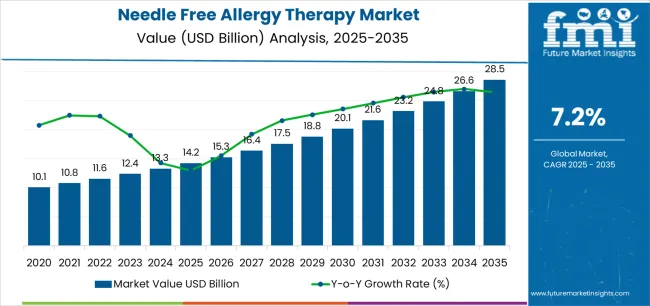
Needle Free Allergy Therapy Market Key Takeaways
| Metric | Value |
|---|---|
| Market Value (2025) | USD 14,232.7 million |
| Market Forecast Value (2035) | USD 28,524.3 million |
| Forecast CAGR (2025 to 2035) | 7.2% |
Between 2025 and 2030, the needle free allergy therapy market is projected to expand from USD 14,232.7 million to USD 20,649.1 million, resulting in a value increase of USD 6,416.4 million, which represents 44.9% of the total forecast growth for the decade. This phase of development will be shaped by rising demand for patient-friendly treatment options and non-invasive therapeutic technologies, product innovation in antihistamine formulations and sublingual immunotherapy applications, as well as expanding integration with pediatric care systems and homecare management platforms. Companies are establishing competitive positions through investment in advanced delivery technologies, patient-centric formulations, and strategic market expansion across allergy clinics, pediatric centers, and primary care applications.
From 2030 to 2035, the market is forecast to grow from USD 20,649.1 million to USD 28,524.3 million, adding another USD 7,875.2 million, which constitutes 55.1% of the ten-year expansion. This period is expected to be characterized by the expansion of advanced needle-free applications, including next-generation transdermal delivery systems and sophisticated oral immunotherapy protocols tailored for specific allergic conditions, strategic collaborations between pharmaceutical manufacturers and allergy specialists, and an enhanced focus on homecare integration standards and self-administration protocols. The growing emphasis on patient convenience and pediatric care will drive demand for comprehensive needle-free allergy solutions across diverse healthcare applications.
The needle free allergy therapy market grows by enabling healthcare providers and pharmaceutical companies to optimize patient compliance while accessing advanced non-invasive treatment technologies without substantial clinical infrastructure investment. Healthcare companies and allergy specialists face mounting pressure to develop patient-friendly treatment options and convenient therapeutic capabilities while managing complex adherence requirements, with needle-free systems typically providing 40-60% improvement in patient compliance compared to injection-based alternatives, making advanced non-invasive technologies essential for competitive healthcare positioning. The pharmaceutical industry's need for patient-centric treatment delivery and application-specific therapeutic capabilities creates demand for comprehensive needle-free allergy solutions that can provide superior convenience, maintain consistent therapeutic standards, and ensure reliable treatment outcomes without compromising clinical effectiveness or patient comfort.
Government initiatives promoting patient-centered healthcare and treatment accessibility drive adoption in allergy clinics, pediatric centers, and homecare applications, where patient compliance has a direct impact on therapeutic success and long-term healthcare effectiveness. Regulatory complexity constraints during approval processes and the expertise requirements for advanced formulation integration may limit accessibility among smaller pharmaceutical companies and developing regions with limited technical infrastructure for sophisticated drug delivery systems.
The market is segmented by therapy type, dosage form, end user, and region. By therapy type, the market is divided into antihistamines, intranasal corticosteroids, decongestants, sublingual immunotherapy, oral immunotherapy, epicutaneous immunotherapy, and others. Based on dosage form, the market is categorized into tablets/capsules, nasal sprays, oral liquids/drops, and transdermal patches. By end user, the market includes allergy & immunology clinics, pediatric centers, primary care/general practitioners, and homecare/self-administration. Regionally, the market is divided into Asia Pacific, Europe, North America, and other key regions.
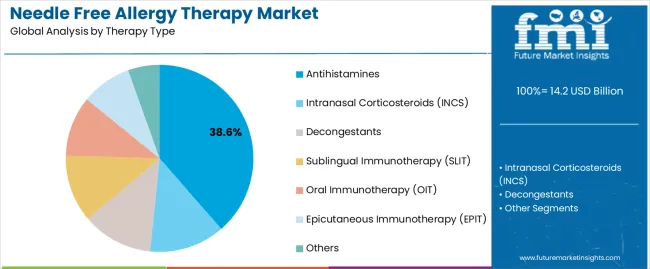
The antihistamines segment represents the dominant force in the needle free allergy therapy market, capturing approximately 38.6% of total market share in 2025. This established therapy category encompasses solutions featuring advanced histamine receptor blocking mechanisms and specialized allergy treatment applications, including high-performance symptom relief properties and enhanced patient tolerability characteristics that enable superior therapeutic benefits and treatment outcomes across all allergic applications. The antihistamines segment's market leadership stems from its proven therapeutic capabilities, with solutions capable of addressing diverse allergic requirements while maintaining consistent efficacy standards and treatment effectiveness across all patient populations.
The intranasal corticosteroids segment maintains a substantial 18.2% market share, serving allergic applications that require specialized anti-inflammatory properties with enhanced local therapeutic effects for nasal and respiratory allergic conditions. These solutions offer advanced inflammation control capabilities for complex allergic reactions while providing sufficient therapeutic characteristics to meet clinical and patient treatment demands. The sublingual immunotherapy segment accounts for approximately 14.4% of the market, serving applications requiring gradual allergen exposure or specialized desensitization protocols.
Key therapy type advantages driving the antihistamines segment include:
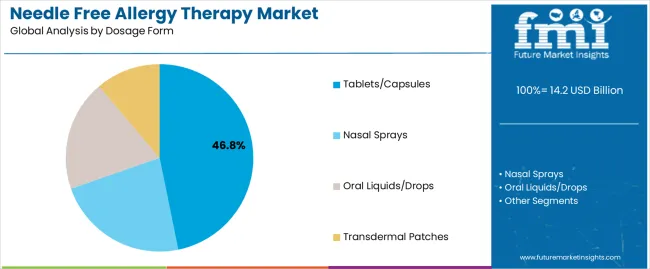
Tablets/capsules applications dominate the needle free allergy therapy market with approximately 46.8% market share in 2025, reflecting the critical role of oral formulations in supporting patient-friendly treatment requirements and therapeutic convenience worldwide. The tablets/capsules segment's market leadership is reinforced by increasing patient preference trends, treatment accessibility requirements, and rising needs for self-administration capabilities in healthcare applications across developed and emerging markets.
The nasal sprays segment represents the second-largest dosage form category, capturing 25.5% market share through specialized requirements for localized delivery systems, respiratory allergy treatments, and targeted therapeutic applications. This segment benefits from growing respiratory allergy demand that requires specific delivery requirements, clinical effectiveness standards, and therapeutic optimization protocols in specialty healthcare markets.
The oral liquids/drops segment accounts for 19.3% market share, serving pediatric applications, swallowing difficulty patients, and specialized liquid formulation requirements across various healthcare sectors.
Key market dynamics supporting dosage form growth include:
The market is driven by three concrete demand factors tied to healthcare and patient outcomes. First, advanced patient compliance initiatives and needle-free treatment solutions create increasing demand for non-invasive allergy therapy systems, with adherence improvement of 15-25% annually in major healthcare applications worldwide, requiring comprehensive needle-free infrastructure. Second, government initiatives promoting patient-centered healthcare and treatment accessibility drive increased adoption of needle-free allergy therapies, with many countries implementing healthcare modernization programs and regulatory frameworks for patient convenience by 2030. Third, technological advancements in drug delivery systems and formulation sciences enable more efficient and effective non-invasive solutions that improve patient outcomes while reducing treatment barriers and healthcare complexity.
Market restraints include complex formulation requirements and validation costs for needle-free platforms that can challenge market participants in developing compliant therapeutic capabilities, particularly in regions where regulatory pathways for advanced drug delivery remain evolving and uncertain. Technical complexity of sophisticated delivery systems and bioavailability requirements pose another significant challenge, as needle-free therapies demand advanced formulation methods and stability protocols, potentially affecting development costs and operational efficiency. Patient education constraints from complex self-administration protocols across different therapeutic applications create additional operational challenges for healthcare providers, demanding ongoing investment in training programs and compliance assurance initiatives.
Key trends indicate accelerated adoption in Asia-Pacific markets, particularly India and China, where healthcare modernization and patient preference shifts drive comprehensive needle-free allergy therapy adoption. Technology integration trends toward advanced delivery systems with enhanced patient convenience characteristics, sophisticated formulation applications, and integrated homecare solutions enable effective treatment approaches that optimize therapeutic efficiency and minimize administration barriers. The market thesis could face disruption if significant advances in traditional injection therapies or major changes in allergy treatment paradigms reduce reliance on conventional needle-free therapeutic applications.
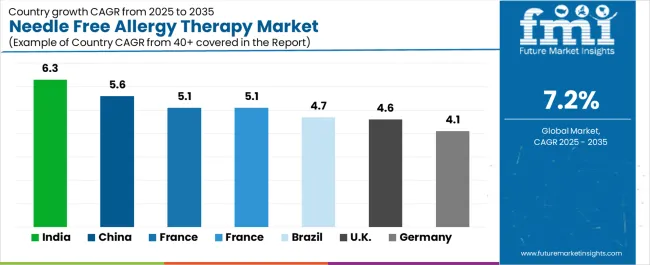
| Country | CAGR (%) |
|---|---|
| India | 6.3% |
| China | 5.6% |
| France | 5.1% |
| USA | 5.1% |
| Brazil | 4.7% |
| UK | 4.6% |
| Germany | 4.1% |
The global needle free allergy therapy market is expanding steadily, with India leading at a 6.3% CAGR through 2035, driven by healthcare accessibility improvements, government patient care initiatives, and advanced pharmaceutical platforms. China follows at 5.6%, supported by healthcare modernization, large-scale pharmaceutical programs, and allergy treatment development initiatives. France and U.S. both record 5.1%, reflecting established landscapes with growing integration in allergy care and patient-centered applications. Brazil grows at 4.7%, anchored by healthcare expansion and pharmaceutical industry development. U.K. advances at 4.6%, leveraging healthcare excellence and allergy treatment applications, while Germany grows steadily at 4.1%, emphasizing regulatory precision and pharmaceutical excellence.
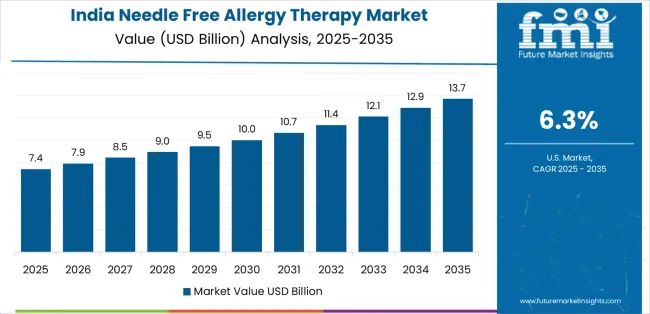
India demonstrates the strongest growth potential in the needle free allergy therapy market with a CAGR of 6.3% through 2035. The country's leadership position stems from healthcare sector modernization, government-backed patient care initiatives, and comprehensive pharmaceutical accessibility regulations driving the adoption of advanced needle-free allergy solutions. Growth is concentrated in major healthcare and pharmaceutical centers, including Mumbai, Delhi, Bangalore, and Chennai, where pharmaceutical companies and allergy specialists are implementing advanced needle-free systems for enhanced patient care capabilities and treatment accessibility. Distribution channels through retail pharmacies and healthcare providers expand deployment across medical facilities and homecare development initiatives. The country's Central Drugs Standard Control Organisation provides policy support for pharmaceutical technology modernization, including comprehensive patient-centric treatment capability development programs.
Key market factors:
In major healthcare and pharmaceutical centers including Beijing, Shanghai, Shenzhen, and Guangzhou, the adoption of comprehensive needle-free allergy solutions is accelerating across healthcare projects and pharmaceutical development initiatives, driven by healthcare scaling and government patient care programs. The market demonstrates strong growth momentum with a CAGR of 5.6% through 2035, linked to comprehensive healthcare modernization and increasing focus on patient convenience solutions. Chinese companies are implementing advanced needle-free systems and delivery platforms to enhance healthcare performance while meeting growing demand in expanding allergy treatment and pharmaceutical sectors. The country's healthcare development initiatives create continued demand for needle-free technologies, while increasing emphasis on innovation drives adoption of advanced therapeutic systems.
Key development areas:
Needle free allergy therapy marketexpansion in France is driven by diverse healthcare demand, including allergy treatment development in major cities and comprehensive patient care projects across multiple regions. The country demonstrates strong growth potential with a CAGR of 5.1% through 2035, supported by national healthcare programs and industry-level pharmaceutical development initiatives. French companies face implementation challenges related to regulatory complexity and scaling requirements, requiring strategic development approaches and support from specialized needle-free therapy partners. Growing healthcare demands and advanced treatment requirements create compelling business cases for needle-free allergy adoption, particularly in patient care areas where convenient treatments have a direct impact on therapeutic success and healthcare competitiveness.
Market characteristics:
USA market expansion is driven by diverse healthcare demand, including allergy treatment development in major cities and comprehensive patient care projects across multiple regions. The country demonstrates strong growth potential with a CAGR of 5.1% through 2035, supported by federal healthcare programs and industry-level pharmaceutical development initiatives. American companies face implementation challenges related to regulatory complexity and scaling requirements, requiring strategic development approaches and support from specialized needle-free therapy partners. Growing healthcare demands and advanced treatment requirements create compelling business cases for needle-free allergy adoption, particularly in allergy care areas where patient-friendly treatments have a direct impact on therapeutic success and healthcare competitiveness.
Market characteristics:
Needle free allergy therapy marketexpansion in Brazil is driven by diverse pharmaceutical demand, including allergy treatment development in major cities and comprehensive healthcare projects across multiple regions. The country demonstrates strong growth potential with a CAGR of 4.7% through 2035, supported by federal pharmaceutical programs and industry-level healthcare development initiatives. Brazilian companies face implementation challenges related to healthcare complexity and scaling requirements, requiring strategic development approaches and support from specialized needle-free therapy partners. Growing healthcare demands and advancing treatment requirements create compelling business cases for needle-free allergy adoption, particularly in patient care areas where accessible treatments have a direct impact on therapeutic success and healthcare competitiveness.
Market characteristics:
UK's needle free allergy therapy market demonstrates advanced implementation focused on clinical precision and patient care optimization, with documented integration of needle-free systems, achieving 40% improvement in patient compliance across healthcare and allergy treatment facilities. The country maintains steady growth momentum with a CAGR of 4.6% through 2035, driven by healthcare facilities' emphasis on patient excellence and continuous care methodologies that align with British healthcare standards applied to needle-free operations. Major healthcare areas, including England, Scotland, Wales, and Northern Ireland, showcase advanced deployment of needle-free platforms where therapeutic systems integrate seamlessly with existing healthcare infrastructure and comprehensive patient management programs.
Key market characteristics:
Germany's needle free allergy therapy market demonstrates established and precision-focused landscape, characterized by advanced integration of needle-free technology with existing pharmaceutical infrastructure across healthcare facilities, regulatory networks, and modernization initiatives. Germany's emphasis on regulatory excellence and pharmaceutical innovation drives demand for high-quality needle-free solutions that support comprehensive healthcare initiatives and treatment requirements in medical operations. The market benefits from partnerships between international needle-free providers and domestic pharmaceutical leaders, creating service ecosystems that prioritize regulatory excellence and quality programs. Healthcare centers in major regions showcase developing needle-free implementations where therapeutic systems achieve efficiency improvements through integrated pharmaceutical programs.
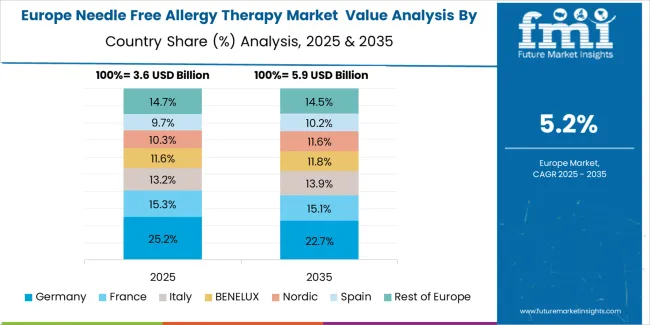
The needle free allergy therapy market in Europe is projected to grow from USD 3,354.4 million in 2025 to USD 5,132.0 million by 2035, registering a CAGR of 4.3% over the forecast period. Germany is expected to maintain its leadership position with a 26.0% market share in 2025, projected to reach 25.4% by 2035, supported by its extensive pharmaceutical infrastructure, advanced healthcare facilities, and comprehensive regulatory networks serving major European markets.
Spain follows with a 17.0% share in 2025, projected to reach 16.8% by 2035, driven by comprehensive allergy treatment programs in major healthcare regions implementing advanced needle-free systems. France holds a 15.4% share in 2025, expected to reach 16.5% by 2035 through the ongoing development of pharmaceutical facilities and healthcare networks. BENELUX commands a 7.0% share, projected to reach 6.6% by 2035, while Nordic Countries account for 6.3% in 2025, expected to reach 5.7% by 2035. The Rest of Western Europe region is anticipated to maintain momentum, holding its collective share at 22.6% in 2025 and 22.5% by 2035, attributed to consistent needle-free therapy adoption across emerging European healthcare facilities implementing patient care programs.
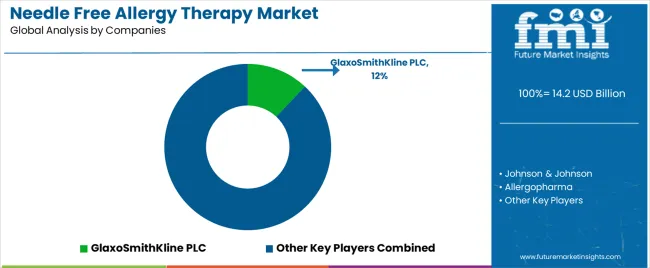
The needle free allergy therapy market features approximately 15-20 meaningful players with moderate concentration, where the top three companies control roughly 25-35% of global market share through established pharmaceutical portfolios and extensive healthcare relationships. Competition centers on formulation innovation, patient convenience, and therapeutic effectiveness rather than price competition alone.
Market leaders include GlaxoSmithKline PLC, Johnson & Johnson, and Sanofi SA, which maintain competitive advantages through comprehensive needle-free therapy portfolios, advanced formulation capabilities, and deep expertise in the allergy treatment and pharmaceutical sectors, creating high switching costs for healthcare providers. These companies leverage established medical relationships and ongoing clinical partnerships to defend market positions while expanding into adjacent pediatric care and homecare applications.
Challengers encompass Allergopharma and McNeil Consumer Healthcare, which compete through specialized delivery technologies and strong clinical presence in key allergy treatment markets. Pharmaceutical specialists, including Genentech Inc., Leti Pharma, and Alerpharma S.A., focus on specific needle-free applications or vertical markets, offering differentiated capabilities in immunotherapy systems, specialized formulations, and application-specific delivery protocols.
Regional players and emerging needle-free therapy companies create competitive pressure through innovative formulation approaches and rapid development capabilities, particularly in high-growth markets including India and China, where local presence provides advantages in cost optimization and regulatory compliance. Market dynamics favor companies that combine advanced formulation technologies with comprehensive healthcare services that address the complete treatment lifecycle from development through ongoing patient support and clinical monitoring.
Needle-free allergy therapy solutions represent a critical healthcare technology that enables allergy specialists, healthcare providers, and pharmaceutical companies to enhance patient compliance and treatment accessibility without substantial clinical infrastructure investment, typically providing 40-60% improvement in patient adherence compared to injection-based alternatives while ensuring unprecedented treatment convenience and therapeutic compliance. With the market projected to grow from USD 14,232.7 million in 2025 to USD 28,524.3 million by 2035 at a 7.2% CAGR, these solutions offer compelling advantages - superior patient convenience, enhanced therapeutic accessibility, and treatment compliance capabilities - making them essential for allergy & immunology clinics (32.8% market share), pediatric centers (28.1% share), and diverse healthcare applications seeking patient-friendly allergy solutions. Scaling market penetration and therapeutic capabilities requires coordinated action across healthcare policy, pharmaceutical standards, needle-free therapy providers, healthcare organizations, and medical institutions.
Key Players in the Needle Free Allergy Therapy Market
| Items | Values |
|---|---|
| Quantitative Units (2025) | USD 14,232.7 million |
| Therapy Type | Antihistamines, Intranasal Corticosteroids, Decongestants, Sublingual Immunotherapy, Oral Immunotherapy, Epicutaneous Immunotherapy, Others |
| Dosage Form | Tablets/Capsules, Nasal Sprays, Oral Liquids/Drops, Transdermal Patches |
| End User | Allergy & Immunology Clinics, Pediatric Centers, Primary Care/General Practitioners, Homecare/Self-Administration |
| Regions Covered | Asia Pacific, Europe, North America, Latin America, Middle East & Africa |
| Countries Covered | India, China, France, USA, Brazil, UK, Germany, and 40+ countries |
| Key Companies Profiled | GlaxoSmithKline PLC, Johnson & Johnson, Allergopharma, Sanofi SA, McNeil Consumer Healthcare, Genentech Inc., Leti Pharma, Alerpharma S.A., Allergan Inc., Meda Pharmaceuticals Inc. |
| Additional Attributes | Dollar sales by therapy type and dosage form categories, regional adoption trends across Asia Pacific, Europe, and North America, competitive landscape with pharmaceutical providers and healthcare companies, formulation facility requirements and specifications, integration with healthcare initiatives and patient care platforms, innovations in delivery technology and pharmaceutical systems, and development of patient-friendly applications with therapeutic quality and compliance optimization capabilities. |
The global needle free allergy therapy market is estimated to be valued at USD 14.2 billion in 2025.
The market size for the needle free allergy therapy market is projected to reach USD 28.5 billion by 2035.
The needle free allergy therapy market is expected to grow at a 7.2% CAGR between 2025 and 2035.
The key product types in needle free allergy therapy market are antihistamines, intranasal corticosteroids (incs), decongestants, sublingual immunotherapy (slit), oral immunotherapy (oit), epicutaneous immunotherapy (epit) and others.
In terms of dosage form, tablets/capsules segment to command 46.8% share in the needle free allergy therapy market in 2025.






Full Research Suite comprises of:
Market outlook & trends analysis
Interviews & case studies
Strategic recommendations
Vendor profiles & capabilities analysis
5-year forecasts
8 regions and 60+ country-level data splits
Market segment data splits
12 months of continuous data updates
DELIVERED AS:
PDF EXCEL ONLINE
Needle Coke Market Size and Share Forecast Outlook 2025 to 2035
Needleloom Machine Market Analysis - Size, Share, and Forecast Outlook 2025 to 2035
Needle Nose Pliers Market Size and Share Forecast Outlook 2025 to 2035
Needle Destroyer Market Size and Share Forecast Outlook 2025 to 2035
Needlecraft Patterns Market Analysis - Growth & Demand 2025 to 2035
Needle-Free Injection System Market Size and Share Forecast Outlook 2025 to 2035
Needle-Free Injectors Market Size and Share Forecast Outlook 2025 to 2035
Needle-Free Vaccine Injectors Market – Demand & Forecast 2024-2034
Pen Needles Market Analysis - Size, Share, and Forecast Outlook 2025 to 2035
Microneedle Drug Delivery Systems Market Report - Growth & Forecast 2025 to 2035
Tattoo Needles Market Size and Share Forecast Outlook 2025 to 2035
Safety Needles Market Size and Share Forecast Outlook 2025 to 2035
Global Suture Needles Market Analysis - Size, Share & Forecast 2024 to 2034
Steerable Needle Market Size and Share Forecast Outlook 2025 to 2035
High Flow Needle Sets Market
Disposable Needle Guides Market
Retractable Needle Safety Syringes Market Size and Share Forecast Outlook 2025 to 2035
Retractable Needles Market
Vertebroplasty Needles Market Size and Share Forecast Outlook 2025 to 2035
Cardiovascular Needle Market – Growth & Forecast 2025 to 2035

Thank you!
You will receive an email from our Business Development Manager. Please be sure to check your SPAM/JUNK folder too.
Chat With
MaRIA